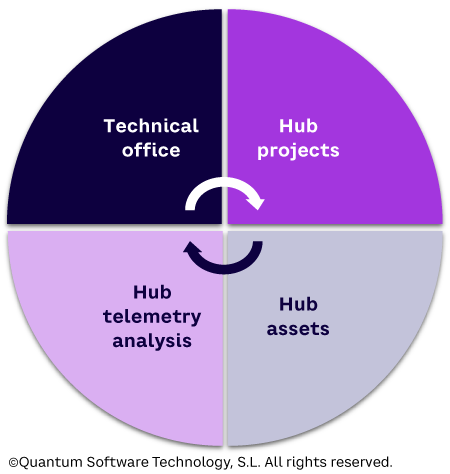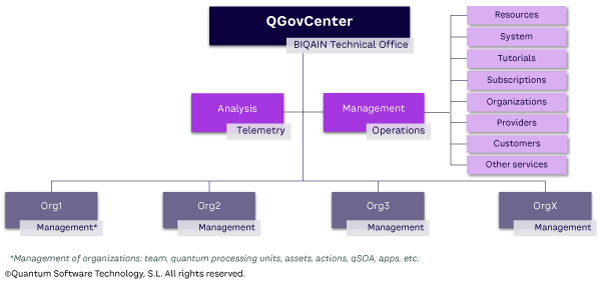AMPLIFY VOL. 38, NO. 3

We are entering a new era in which quantum computing will provide enormous advantages to companies in sectors such as healthcare, banking, agriculture, logistics, life sciences, security, and many more. The integration of quantum computing, AI, and classical computing into hybrid multicloud workflows is set to drive the most significant computing revolution in 60 years.1
However, to successfully leverage this technology, a significant number of risks and challenges must be considered. These include: lack of qualified quantum workers; non-user-friendly graphical user interfaces; incompatibility between quantum systems; diversity of quantum programming languages; difficult compilation and debugging; integration of classical and quantum IT; migration of classical software to quantum applications; scalability, portability, integration, and interoperability issues; development, deployment, maintenance, operation, and sustainability costs; and complex design and validation processes.2,3 These challenges must be addressed to create a quantum ecosystem that goes beyond experiments and proofs of concept.
From a business perspective, quantum software engineering (QSE) should first focus on making quantum computing accessible to developers and users through appropriate processes, methods, and tools. It should also facilitate hybrid quantum computing through a combination of classical software engineering and QSE.4 By addressing these challenges and using emerging business models like quantum computing as a service (QCaaS) and quantum software as a service (QSaaS), the industry will be able to take advantage of quantum innovations and monetize quantum software.5
Managing Quantum Ecosystems
Each quantum hardware vendor provides proprietary elements that must be understood and controlled to build quantum solutions. Each vendor has its own Web portals, compliance requirements, technologies/frameworks, constraints, and coding (note that refactorings and updates are continuous and carry the risk of breaking solutions due to compatibility issues and code dependencies).6
Currently, there are two main advanced technological approaches (quantum gates and annealing) plus novel, highly specialized machines separate from the main groups that will eventually converge with the mainstream ones or give rise to new approaches.
Additionally, since resources are scarce, access to remote quantum processors/simulators depends on execution queues that must be controlled in order to not lose the experiment — exponentially increasing the complexity of managing the quantum process.
Each supplier sets up functionalities to manage the process in its closed environment, always from its specific prism, without considering other suppliers’ platforms. Customers who work with multiple quantum hardware suppliers must manage consumption and assets with each vendor according to their rules and controls. The more suppliers and users, the less efficient the management.
This situation is becoming increasingly common, in part because of the growing supply of quantum hardware services. It’s also due to the increased adoption of quantum computing by complex organizations with large numbers of users (e.g., universities, research centers, public institutions, and large enterprises), resulting in a need to simultaneously use multiple technologies and quantum approaches.
Quantum computers are scarce and expensive, and they don’t yet work with full accuracy. Many critical questions must be answered at the beginning of the quantum development process, and complex analyses must be performed to determine how to achieve the desired quantum advantage.
However, large quantum computing projects, as currently managed, are increasingly unwieldy. Not only do these projects involve quantum computers from multiple providers, a variety of technologies, and complex cost tracking, but each is accessed by as many organizational units, teams, and users. Without intermediate mechanisms that allow centralized management of access, resources, and consumption, costs tend to spiral out of control and can lead to project failure. Attempts to measure, analyze, and control costs tend to be isolated in user-defined micro-silos, which is a huge impediment to thorough analysis and cost control.
This situation also affects the technical level, where the assets developed in the creation process tend to be hosted in a large number of developed environments managed in a specific way. This results in a lack of control over quantum solutions, which threatens the ability of companies to offer QSE as a (profitable) service.
Private Quantum Hubs as a Solution
Companies, institutions, and individuals will need to work together to find ways to securely and efficiently manage quantum computing resources while maintaining quality and ensuring scalability. We believe private quantum hubs (PQHs) are an effective way to address this need, provided they are supported by a specialized organization that applies an effective governance system.
PQHs allow complex organizations with multiple users, customers, suppliers, and projects to experiment with various quantum technologies in private environments. A PQH lets organizations access services and quantum computing either in the cloud, through their own quantum computing centers, or in a hybrid format.
The success of large quantum computing projects largely depends on efficiently managing and unifying resources. Current examples include AWS and Microsoft, which developed PQHs (Braket and Azure Quantum, respectively) that offer quality, unified access to quantum platforms from a variety of manufacturers. For similar reasons, but on a different scale, companies and institutions that create PQHs also need tools and methods to manage projects.
Quantum Governance Systems
Centralized governance of a PQH is a complex undertaking. First, the governance system must encompass and control a broad framework of disparate activities and tools. Second, it must function as part of a system that includes:
-
Integration of multiple quantum devices and technologies and their limitations, security definitions, and costs
-
Platforms and tools for on-premise quantum and hybrid software development
-
Tools for deploying and managing QSaaS
-
The ability to adapt to multiple deployment contexts and platform usage over the PQH’s lifetime
We don’t have the space to go into each of these elements in depth in this article, but we note that the viability of complex PQHs depends on having a tailor-made management strategy (see Figure 1), with the following elements as a minimum:
-
Service model. This must be designed for large institutions and companies with complex organizational structures to ensure quantum data and assets are isolated, protected, processed, packaged, and transmitted as efficiently as possible in a secure, non-shared, private environment.
-
Management model. This facilitates centralized management of remote access to the hub’s various quantum platforms, enabling traceability of all PQH activities.
-
Dedicated governance software. This must meet the needs of everyone in the PQH, including hub administrators, business users, and researchers.

Currently, there are only a few platforms for quantum software development that include defined, specialized systems for managing private quantum nodes.
The cloud services platforms of Amazon, Google, and Microsoft Azure include functionality for managing general situations, but they were not designed as specialized services for quantum software hubs, making it difficult to take control of each one, even for a short time.
There are several third-party quantum software development platforms, but they were designed as end-user development tools, so they don’t include the basic elements needed for lifecycle management, hybrid system architecture, or quantum software ecosystems.7
We believe the solution is a centralized system that specializes in governing complex quantum ecosystems with multiple actors (technology providers, customers, customers’ users, development teams with multiple roles, business users, researchers, and individuals).
Use Case: Bizkaia Quantum Advanced Industries
Bizkaia Quantum Advanced Industries (BIQAIN), an industry-focused quantum ecosystem in Spain’s Basque Country, uses a centralized PGH governance tool.8 It was developed to:
-
Offer quantum services to companies with the aim of connecting supply and demand, so that companies of all sizes in Bizkaia can learn about the possibilities of this technology by creating and testing potential market solutions
-
Provide training and capacity-building services for companies and society
-
Stimulate cooperation between research centers, universities, and businesses
BIQAIN provides remote access to various quantum platforms to promote the development/operation of hybrid quantum/classical systems, including:
-
Companies seeking proofs of concept to demonstrate the usefulness of quantum computing for daily activities
-
Universities and research centers aiming to expand quantum knowledge in the region
-
Vendors offering quantum computing services (e.g., Amazon Braket, D-Wave Systems, IBM, IQM, Microsoft Azure Quantum, and Fujitsu)
-
Start-ups and larger companies providing support services for business adoption of quantum computing
As a requirement of the Bizkaia Provincial Council’s support, the BIQAIN ecosystem must guarantee an isolated connection to quantum hardware for each business, research organization, and expert member that uses it. BIQAIN must also provide analytical tools to help users determine how to achieve their desired quantum advantage, along with tools for cost control. For example, the BIQAIN technical office can set a cost threshold for each project and receive a warning from the system when it is about to exceed it (or even block access to payment resources). This functionality can be extended to individual users of each project.
BIQAIN was created using a customized version of QuantumPath, a platform for developing hybrid classical/quantum solutions.9 BIQAIN uses Q|PrivateHub as the service model, Q|MGMTmodel for management, and Q|GovCenter for governance.
The service model was created to meet the needs of the BIQAIN ecosystem, taking into account the complexity of its organizational structure. It includes 12 quantum platforms and incorporates tools from various vendors for industrial quantum software development, industry-ready hybrid quantum/classical software development, implementation/management of a future QSaaS, and a centralized governance model. The service model provides:
-
A private, secure environment, deployed within the IT infrastructure of participating organizations (e.g., companies, universities, and research centers)
-
Sizing and scaling of the service according to changing needs
-
Definition and implementation of policies for digital governance
-
Professional managed services
-
Basic training on the use of hub services and technical support
-
Marketing to promote the service and encourage use
-
Dashboards on user usage and activities
The quantum hub management model shown in Figure 2 comprises the following:
-
Technical office. This is the top functional unit of the management model, providing participating organizations with access to each platform and all project services (e.g., general service management parameters, customer management, and budgeting). Experts in quantum software development management run the technical office.
-
Hub projects. The technical office registers isolated spaces for each organization. The project model defines the scope of work for each organization’s team and its users, including security, costs, and policies.
-
Hub assets. These are created by use-case development teams through the creation of quantum assets such as circuits, flows, applications, direct code, and the development of n-layer clients that can run on simulators or quantum processing units. Results can be analyzed multiple times, democratizing access to quantum processing units.
-
Hub telemetry analysis. This focuses on accessing product telemetry information and indicators, allowing access to all data associated with lifecycle and execution. This makes it possible to access process information (asset lifecycle length, supplier benchmarking, execution times and costs, estimated energy consumption, and more).

Figure 3 shows how Q|GovCenter provides tools for the unified management of the BIQAIN ecosystem, including how organizations participate in the hub with their respective users, requesters, suppliers, etc. Q|GovCenter allows the BIQAIN technical office to define general and specific policies to be applied to each organization and its administrators and centrally assign contracts, quantum providers, and service requesters; approve projects; and set tariffs and consumption limits. Once the organization is created, BIQAIN’s administrator uses Q|GovCenter to assign resources and policies (equipment, user-access permissions, assigned quantum processing units, assets created by the organization, authorized actions, quantum/classical integrations with quantum service-oriented architecture, and access to assigned quantum platforms).

Q|GovCenter also facilitates analysis of the ecosystem, using a telemetry model. An analysis dashboard (by organization) benchmarks various hardware and simulators, both on cost/time and the sustainability of each option.
Each organization can use tools that support and automate management of its work teams (users, roles, permissions); quantum processing units (with their credentials and connection requirements); assets (complete solutions, circuits, resources); and compilation, transpilation, and execution tracking.
Q|GovCenter also assists with two key aspects of Bizkaia Provincial Council’s business-related strategy:
-
Management and control of the lifecycle of quantum/classical hybrid systems development projects, essential for the successful application of quantum computing in business.10
-
The metrics of processes, methods, and tools that, following QSE best practices, directly affect the productivity of projects and the quality of quantum and hybrid systems. This helps keep costs under control and facilitates practical applications of the quantum advantage to businesses.11
Conclusion
A good governance system is fundamental to a complex quantum ecosystem with multiple actors. It must consider each hub’s needs and growth plans in order to provide:
-
A service managed by experts in quantum computing services
-
The technical knowledge to create a quantum enterprise network
-
Implementation of the infrastructure needed to operate and grow the hub
-
Unified management of organizations, users, and suppliers
-
Centralized control of pay-per-use quantum computing budget line items
-
Professional consulting to define, size, and customize the hub as needed
-
Quantum software services using a QSaaS model
-
Access to unified, real-time usage reports for all hub computers and simulators, as well as member satisfaction surveys
-
Security of intellectual property and all elements needed to ensure safe access to an organization’s assets
We believe this is the best way to move quantum computing from the experimental stage to fully tested solutions that businesses can leverage.
References
1 “The Quantum Decade: A Playbook for Achieving Awareness, Readiness, and Advantage.” 4th edition. IBM Institute for Business Value, 2023.
2 Hevia, José Luis, Guido Peterssen, and Mario Piattini. “Quantum Software Development Risks.” Quantum Information and Computation, Vol. 24, Nos. 5 & 6, 2024.
3 Salam, Masaud, and Muhammad Ilyas. “Quantum Computing Challenges and Solutions in Software Industry — A Multivocal Literature Review.” IET Quantum Communication, Vol. 5, No. 4, June 2024.
4 Carbonelli, Cecilia, et al. “Challenges for Quantum Software Engineering: An Industrial Application Scenario Perspective.” In Quantum Software: Aspects of Theory and System Design, edited by Iaakov Exman et al. Springer, 2024.
5 Kshetri, Nir. “Monetizing Quantum Computing.” IT Professional, Vol. 26, No. 1, January 2024.
6 Piattini, Mario, José Luis Hevia, and Guido Peterssen. “Quantum Software Engineering: Practical Challenges.” International Journal of Software Engineering and Knowledge Engineering, Vol. 34, No. 9, 2024.
7 Hevia, José Luis, et al. ”Quantum Computing.” IEEE Software, Vol. 38, No. 5, September–October 2021.
8 “Industry-Focused Quantum Ecosystem.” Bizkaia Regional Council, accessed 2025.
9 Hevia, José Luis, Guido Peterssen, and Mario Piattini. “QuantumPath: A Quantum Software Development Platform.” Software: Practice and Experience, Vol. 52, No. 6, December 2021.
10 Hevia, José Luis, Guido Peterssen, and Mario Piattini. “qSOA: Dynamic Integration for Hybrid Quantum/Classical Software Systems.” Journal of Systems and Software, Vol. 214, August 2024.
11 Piattini, Mario, et al. “Toward a Quantum Software Engineering.” IT Professional, Vol. 23, No. 1, January–February 2021.




